
|
|
FYBUSH.COM/SITE OF THE WEEK
NEEDS YOUR SUPPORT! (AND YOU CAN GET A FREE TOWER SITE CALENDAR
IF YOU PLEDGE NOW...) CLICK HERE
TO LEARN MORE...
February 26 - March 4, 2004
More Columbus

When we left you last week, we were chasing the last bits of daylight around the south side of Ohio's capital city, heading for one last site before sunset - and what a site it turned out to be!
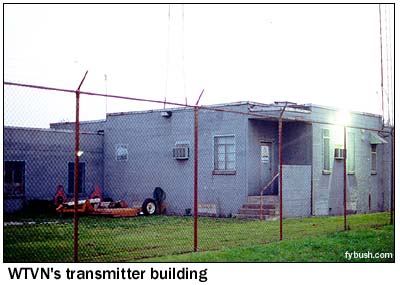 Where
I-270 curves around the southeast side of Columbus (right where
many of those sniper attacks have been frightening motorists)
sits the community of Obetz, Ohio - and it's there, just north
of 270 on Obetz Road, that we find six towers that belong to
Clear Channel's WTVN (610). You can three of them in the photo
montage above - all told, there are five self-supporting towers
that make up part of the six-tower night array and a tall guyed
tower for the day signal that was also once home to WTVN-TV (Channel
6, now WSYX) and WTVN-FM (96.3, now WLVQ).
Where
I-270 curves around the southeast side of Columbus (right where
many of those sniper attacks have been frightening motorists)
sits the community of Obetz, Ohio - and it's there, just north
of 270 on Obetz Road, that we find six towers that belong to
Clear Channel's WTVN (610). You can three of them in the photo
montage above - all told, there are five self-supporting towers
that make up part of the six-tower night array and a tall guyed
tower for the day signal that was also once home to WTVN-TV (Channel
6, now WSYX) and WTVN-FM (96.3, now WLVQ).
Channel 6 began its life out here in 1949, and while its signal from here was never huge, that was a deliberate move - it was co-owned under Taft Broadcasting with WKRC-TV (Channel 12) down the road in Cincinnati, and the FCC would have frowned on signal overlap between the two. (Avco kept the signal of WLWC on channel 4 similarly limited to avoid overlap with WLWT in Cincinnati.)
In 1974, channel 6 moved to the Dodridge Street site we showed you last week, but it's a good thing that tall tower remained behind. Clear Channel will soon use it for a new Columbus move-in: WLZT (93.3 Ashville) is the former WFCB Chillicothe, which was already rimshotting the south side of Columbus from the WWHO-TV (Channel 53) tower in Circleville, some 20 miles south of town; Clear Channel hopes to move it to this site later this year.
(A bit more history: when this site was built, 610 in Columbus was WHKC, a United Broadcasting station that was the result of some frequency shuffles around the state. The 610 frequency had been in Cleveland as United's WCLE, a sister station to WHK, but when the FCC implemented the one-station-to-a-market rule in the mid-40s, United moved 610 to Columbus to replace what had been WAIU, a daytimer on 640. The 640 frequency, in turn, ended up in Akron as WHKK, predecessor of today's WHLO.)
WTVN held a construction permit to build a new site far to the south of here, in Circleville, that would have blasted a 50 kW signal north over Columbus and beyond; it would have required eight new towers, and zoning clearance for the plan never did materialize. So Obetz it is, and even with 5 kW, WTVN is still a facility to be reckoned with. (It's easily heard in Fort Wayne, Cincinnati and even into Cleveland on its daytime non-DA signal.)
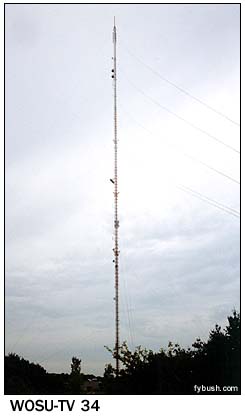
|
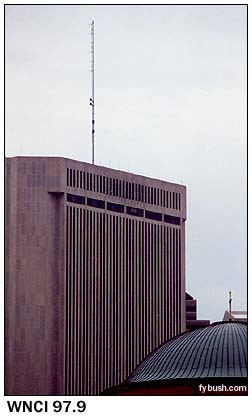
|
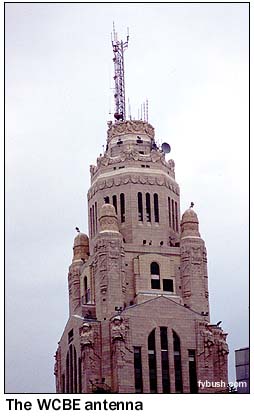
|
As you can see from these pictures, the sun was just about down by the time we took these pictures, and it wasn't much later that we heard WOSU's 820 signal switch sites and drop to night power. A Steak & Shake dinner and a night's sleep later, we were back on the road, finishing up our look around Columbus on a rather cloudier day.
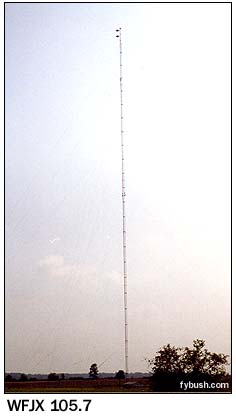 Our
first stop was northwest of town, about three miles outside the
I-270 loop on Ohio 3, on the northern outskirts of Westerville.
This 1125-foot tower, shown at left above, is the tallest stick
in the area, built in 1973 for WOSU-TV 34, the public broadcaster
that's based at Ohio State University. When we visited, it was
home to two other signals as well: Sinclair's Fox affiliate,
WTTE (Channel 28), since relocated to the channel 6 site south
of downtown after considering building a much taller tower north
of here, and WEGE (103.9 Westerville), North American Broadcasting's
classic hits "Eagle". (The current incarnation of 103.9
is actually a fairly recent license; 103.9 in Westerville used
to be jazz station WBBY, which lost its license in the early
nineties.)
Our
first stop was northwest of town, about three miles outside the
I-270 loop on Ohio 3, on the northern outskirts of Westerville.
This 1125-foot tower, shown at left above, is the tallest stick
in the area, built in 1973 for WOSU-TV 34, the public broadcaster
that's based at Ohio State University. When we visited, it was
home to two other signals as well: Sinclair's Fox affiliate,
WTTE (Channel 28), since relocated to the channel 6 site south
of downtown after considering building a much taller tower north
of here, and WEGE (103.9 Westerville), North American Broadcasting's
classic hits "Eagle". (The current incarnation of 103.9
is actually a fairly recent license; 103.9 in Westerville used
to be jazz station WBBY, which lost its license in the early
nineties.)
You can't tell it from the picture, but the channel 34 tower is surrounded by residential development almost to its guy-wire anchors.
Heading back into downtown, it's hard to miss One Nationwide Plaza and the guyed tower on its roof. That's Ohio's most powerful FM station there - the grandfathered 175,000-watt ERP signal of WNCI (97.9) that still blankets most of central Ohio from here. WNCI's studios used to be in this building as well, but when it and the rest of Nationwide Communications was sold to Jacor in 1998, a big shuffle of studios and owners ensued. The Justice Department wouldn't let Jacor hang on to the huge amount of market share it would have had as a result - so while Jacor kept WNCI, it spun off several other stations. WLVQ and rimshotters WHOK (95.5 Lancaster) and WAZU (107.1 Circleville) went to Infinity (in exchange for six Infinity stations in Baltimore, San Jose and Minneapolis), while modern rock WZAZ (98.9 Upper Arlington) went to Radio One and became rhythmic oldies WXMG.
Overnight - literally - half the stations in town had to trade studios. Here's how contributor Kit Sage recalls it: "WCOL AM-FM moved from 2 Nationwide Plaza to the WLVQ facility (in the WTVN building) on Dublin Rd. WLVQ moved from Dublin Rd. to the WCOL studios in 2 Nationwide. WNCI moved from 1 Nationwide Plaza to The Continent, but I don't know which actual studio they occupied. WHOK moved from The Continent to 1 Nationwide Plaza in the former WNCI studio. WZAZ (WXMG) moved from The Continent to the Radio One studios on Third Ave. I don't remember if WAZU 107.1 was located at The Continent or on Dublin Rd. prior to the big change, but they ended up in 2 Nationwide Plaza with WLVQ, using the former control room of WCOL (AM) from what I was told."
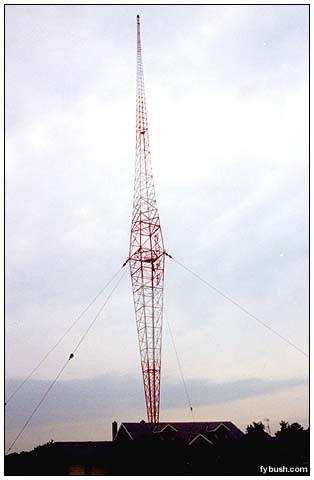 There's
another FM signal on the roof now, too; Clear Channel's WFJX
(105.7 Marysville) had just flipped to classic rock "Fox"
when we drove through in 2000, and it was still running from
the tower shown at left, 10 miles northwest of the I-270 loop
off the side of US 33 near US 42. (This was actually the second
site for 105.7; it started out from a tower north of Marysville
that's now home to WJZK 104.3 Richwood, half of a smooth jazz
simulcast with WJZA 103.5 Lancaster.)
There's
another FM signal on the roof now, too; Clear Channel's WFJX
(105.7 Marysville) had just flipped to classic rock "Fox"
when we drove through in 2000, and it was still running from
the tower shown at left, 10 miles northwest of the I-270 loop
off the side of US 33 near US 42. (This was actually the second
site for 105.7; it started out from a tower north of Marysville
that's now home to WJZK 104.3 Richwood, half of a smooth jazz
simulcast with WJZA 103.5 Lancaster.)
WFJX later changed city of license to Hilliard and relocated its antenna to the roof of One Nationwide Plaza, becoming a full-city signal.
One more neat rooftop site bears mention downtown (in addition to the WCKX 107.5 antenna atop the Borden Building at Fourth and Broad): at the corner of Marconi and Gay sits the LeVeque Tower, a Columbus landmark - and up atop its spire sits the three-bay antenna of WCBE (90.5), the Columbus Board of Education's noncommercial FM that does a mix of NPR news, AAA and world music. There's been a tremendous amount of intrigue surrounding this signal; it's no secret that WOSU would like to add it to its existing station group - or that standalone modern rocker WWCD (101.1 Grove City) covets its downtown transmitter location. Because of the 10.6 MHz (IF) frequency difference between 90.5 and 101.1, WWCD's transmitter has to be at least 15 kilometers from WCBE's, which puts it south of I-270 and makes the 101.1 signal hard to hear in parts of downtown. Despite several proposals to swap towers with WCBE, nothing has developed yet.
Another station whose signal has figured in swap rumors lately is the only AM on Columbus' east side. WBNS (1460) is the proud owner of one of the handful of Blaw-Knox diamond towers still standing, and its lovely transmitter site on Barnett Road, just south of East Main Street, is brimming with history. At 380 feet, the WBNS Blaw-Knox is the second shortest diamond tower in the country (WFEA 1370 in Manchester, New Hampshire has one slightly shorter - and we'll leave WVWA in Pound Ridge for our April 1 edition!), but what it lacks in height it makes up in beauty. The WBNS call letters down the north side of the tower are clearly visible to traffic on Main Street, which is also US 40 - once the main east-west highway into downtown - and the building at its base is from the "they don't build 'em like that anymore" school of transmitter building design.
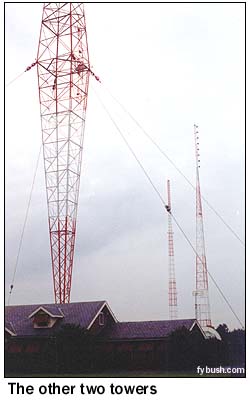 WBNS
uses only this tower only for its 5 kW day signal; at night adds
one of the two conventional self-supporting towers for its 1
kW directional signal, which has long been outgrown by Columbus'
suburban sprawl. I'm told there's an old Collins tube transmitter
in the building for aux use and a Harris DX10, throttled back
to 5 kW, for primary use.
WBNS
uses only this tower only for its 5 kW day signal; at night adds
one of the two conventional self-supporting towers for its 1
kW directional signal, which has long been outgrown by Columbus'
suburban sprawl. I'm told there's an old Collins tube transmitter
in the building for aux use and a Harris DX10, throttled back
to 5 kW, for primary use.
(The other tower, which isn't part of the AM array, still has auxiliary bays for WBNS-FM 97.1; early FM operation WELD-FM was here once, too, providing radio fax service for the Dispatch.)
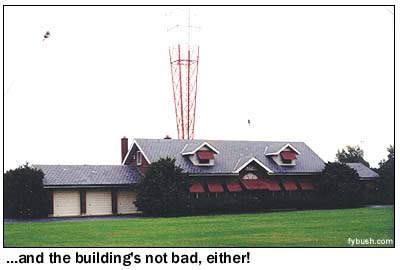
The signal deficiencies of 1460 mean that the prestigious Ohio State sports package that's a cornerstone of WBNS' sports format has to be simulcast on WBNS-FM to reach much of the market, and there's been some talk of trading 1460 for WOSU's somewhat better 820 signal (and somehow ending up with WCBE going to the WOSU group as well.) Time will tell, we suppose - and in the meantime, that's one heck of an impressive tower, isn't it?)
Two more sites on the outskirts of the market will wrap up our visit to Columbus. North of town in Delaware, WDLR (1550) runs 500 watts by day, 29 watts at night from the two short towers out there behind the studio building at the intersection of US 36 and Ohio 37 on the east side of town. (Look carefully to the right of the tower just behind the building!) WDLR was programming religion on this 2000 visit; it's since switched to Spanish and has a pending application to move south to Westerville to better serve Columbus. (Delaware is also the city of license of oldies WODB 107.9, whose tower is something of a landmark on I-71 north of 270, and of beautiful music LPFM WINF-LP 101.9, operating from the WDLR site, which was also the original 107.9 site!)
And over in Union County, northeast of Columbus, US 36 is also where we find the seven towers of WUCO (1270 Marysville). This 500-watt signal was wedged in barely twenty years ago and has to protect co-channel stations in Cambridge, Ohio (75 miles east of Columbus) and in Detroit, among others, and the result is a signal so directional that we were almost within sight of the towers before we could hear the station clearly.
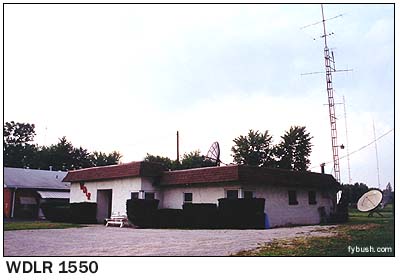
|
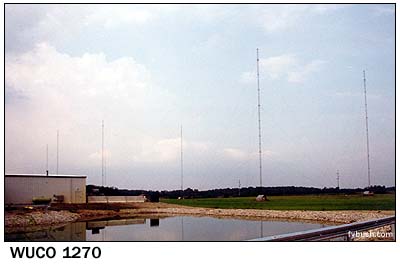
|
That wraps it up for Columbus - but come back next week as we mark the 40th anniversary of an AM station that's already defunct, and see the rest of the interesting sites of New Brunswick's provincial capital!
Still haven't ordered? It's not too late - Tower Site Calendar 2004 is STILL AVAILABLE! All orders placed by Tuesday, February 17 have now been shipped - and if you haven't yet ordered, what are you waiting for? Click here for ordering information!
- Previous Site of the Week: Columbus, Ohio, part I
- Next Week: Fredericton, N.B.
- Site of the Week INDEX!
- How can you help support Site of the Week? Click here!
- Submit your suggestions for a future Site of the Week!
